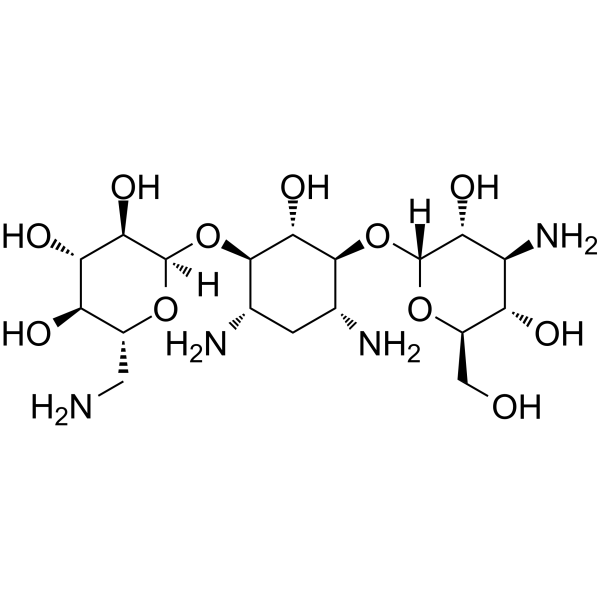59-01-8
| Name | kanamycin A |
|---|---|
| Synonyms |
KANAMYCIN
4,6-Diamino-3-[(6-amino-6-deoxyhexopyranosyl)oxy]-2-hydroxycyclohexyl 3-amino-3-deoxyhexopyranoside kanamycin from Streptomyces kanamyceticus d-deoxydi Kannamycin Monosulfate d-xydi kanamicina KanamycinMonosulfateA Hexopyranoside, 4,6-diamino-3-[(6-amino-6-deoxyhexopyranosyl)oxy]-2-hydroxycyclohexyl 3-amino-3-deoxy- gentamicin A |
| Description | Kanamycin (Kanamycin A) is an orally active antibacterial (gram-negative/positive bacteria) agent, inhibits translocation and causes misencoding by binding to the 70 S ribosomal subunit. Kanamycin shows good inhibitory activity to both M. tuberculosis (sensitive and drug-resistant ) and K. pneumonia, which can be used in studies of tuberculosis and pneumonia[1][2][3][4]. |
|---|---|
| Related Catalog | |
| In Vitro | Kanamycin (0.1-100 μg/mL; 2 weeks) exhibits good antibacterial activity (MIC=1-5 μg/mL) to various strains of mycobacteria in vitro[1]. Cell Viability Assay[1] Cell Line: mycobacteria H37Rv, H2, H37RvR-PAS, Ravenel, Kirchbergand and BCG. Concentration: 0.1-100 μg/mL Incubation Time: 2 weeks Result: Showed good antibacterial activity to various strains of mycobacteria (H37Rv, H2, H37RvR-PAS, Ravenel, and BCG) with MICs were 1 μg/mL and 5 μg/mL for strain of Kirchbergand. |
| In Vivo | Kanamycin (2, 4 mg/kg; s.c.; once daily, 6 times a week for 3 weeks) inhibits growth of bovine tubercle bacilli in lung and spleen of mice[1]. Kanamycin (1.25, 5 mg/kg; s.c.; single (at 3 h after infection)) inhibits the multiplication of K. pneumonia DT-S in lung, trachea, and blood of mice and in proportion to the dose administration, and also increases the survival rate of mice[2]. Animal Model: Inbred strain normal mice (14-16 g; bovine tubercle bacilli (Ravenel strain) infected model)[1]. Dosage: 2, 4 mg/kg Administration: Subcutaneous injection; once daily, 6 times a week for 3 weeks. Result: Exerted a marked effect to inhibit the multiplication of the tuberculosis in vivo, especially in the lung of mice. Animal Model: Slc:ICR male mice (4-week-old; 18-24 g; K. pneumonia DT-S infection model (by the aerosol method))[2]. Dosage: 1.25, 5 mg/kg Administration: Subcutaneous administration; single (at 3 h after infection). Result: Suppressed the growth of K. pneumonia DT-S in lung, trachea, and blood in proportion to the dose administration. Resulted in 90% survival at 6 days after infection (negative control group: all died within 4 days), and cleared the K. pneumonia DT-S from lung, trachea, and blood of mice within 48 h (when dosage at 5 mg/kg). |
| References |
| Density | 1.6±0.1 g/cm3 |
|---|---|
| Boiling Point | 809.5±65.0 °C at 760 mmHg |
| Molecular Formula | C18H36N4O11 |
| Molecular Weight | 484.499 |
| Flash Point | 443.4±34.3 °C |
| Exact Mass | 484.238068 |
| PSA | 282.61000 |
| LogP | -2.58 |
| Vapour Pressure | 0.0±6.5 mmHg at 25°C |
| Index of Refraction | 1.670 |
CHEMICAL IDENTIFICATION
HEALTH HAZARD DATAACUTE TOXICITY DATA
MUTATION DATA
|
| WGK Germany | 2 |
|---|
